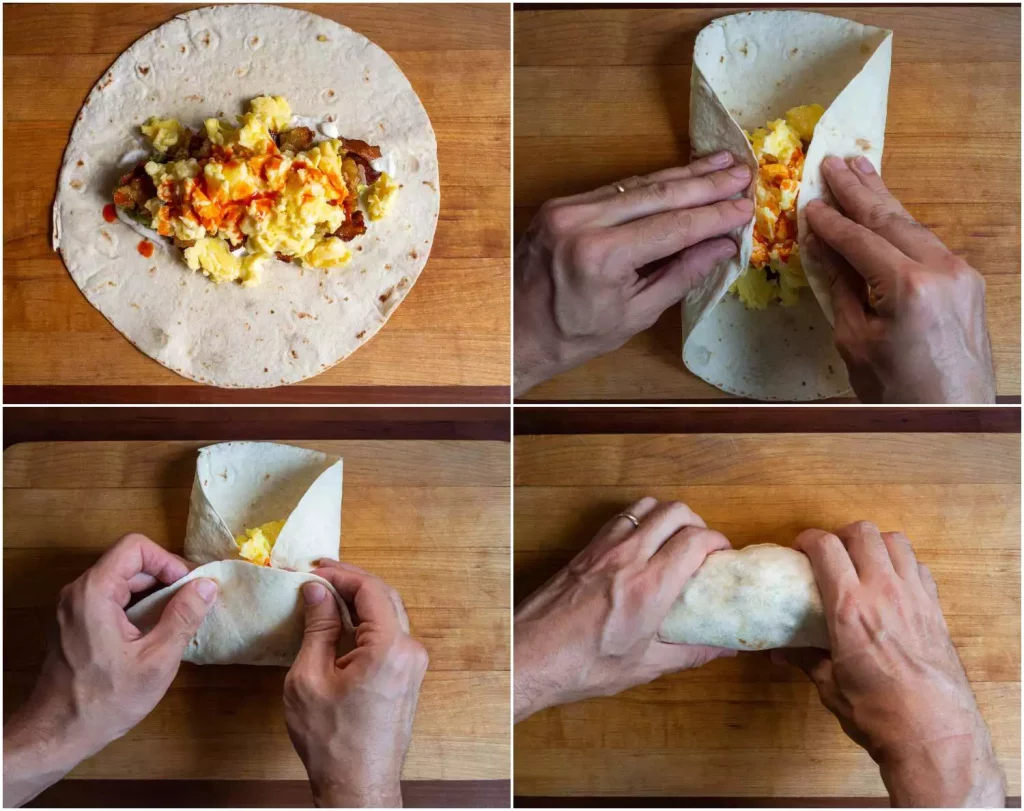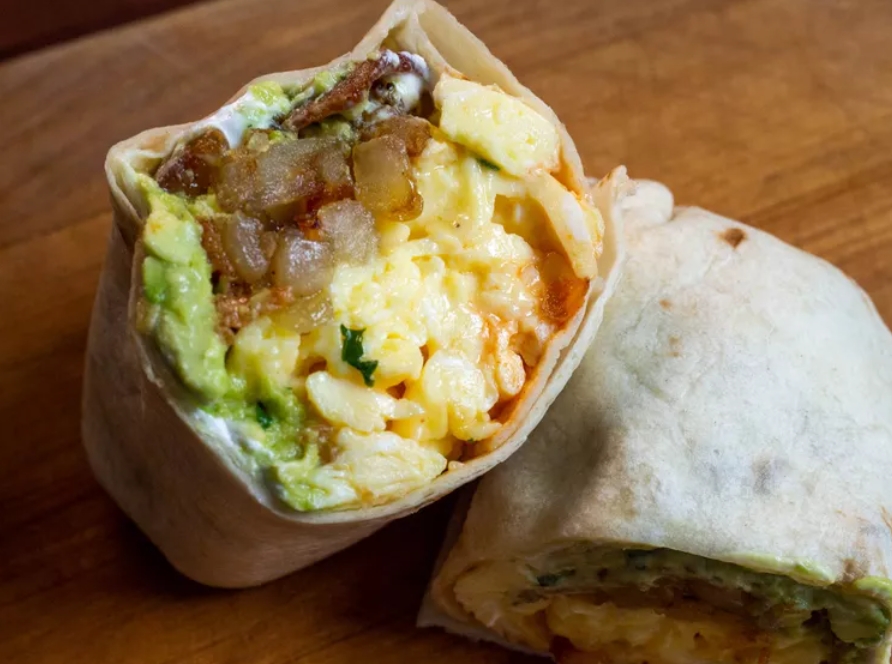The Bacon, Egg, and Cheese Breakfast Burrito is a quintessential breakfast dish that combines savory bacon, creamy eggs, and melted cheese, all wrapped in a soft tortilla. This hearty meal is not only a satisfying start to the day but also a versatile dish that can be customized to fit various tastes and dietary preferences. This extensive guide will delve into the history of the breakfast burrito, provide detailed instructions for making it, explore variations, and offer tips for perfecting this beloved dish.
1. The History and Origins of the Breakfast Burrito
Origins of the Burrito
The burrito, a staple of Mexican cuisine, originated in northern Mexico. The term “burrito” translates to “little donkey” in Spanish, a reference to the rolled shape of the tortilla, which resembles the bedrolls carried by donkeys. Traditional Mexican burritos typically contain beans, meat, and sometimes rice, all wrapped in a flour tortilla.
The breakfast burrito as we know it today has roots in the United States, particularly in the southwestern regions like Texas and New Mexico. This variation emerged in the late 20th century, combining the classic burrito with traditional American breakfast ingredients. The fusion of flavors and the convenience of the burrito format quickly made it a popular choice for breakfast across the country.
Cultural Significance
The breakfast burrito has become an iconic dish in American cuisine, symbolizing the blend of Mexican and American culinary traditions. It reflects the growing trend of fusion cuisine, where diverse culinary practices come together to create something new and exciting. Its popularity has spread beyond the southwestern United States, making its way into mainstream breakfast menus and home kitchens nationwide.
2. Ingredients for Bacon, Egg, and Cheese Breakfast Burrito
Core Ingredients
1. Flour Tortillas:
- Size: Large tortillas (10-12 inches) are ideal for wrapping the fillings securely.
- Type: Soft and pliable tortillas work best. You can use whole wheat or gluten-free tortillas as alternatives.
2. Bacon:
- Quantity: About 6-8 slices of bacon for a hearty burrito.
- Type: Choose thick-cut bacon for a more substantial texture. Turkey bacon can be used as a leaner option.
3. Eggs:
- Quantity: 4-6 large eggs, depending on the number of servings.
- Preparation: Eggs should be beaten and cooked until just set. Scrambled eggs work best for this recipe.
4. Cheese:
- Type: Shredded cheddar cheese is traditional, but other varieties like Monterey Jack, American, or a blend of cheeses can also be used.
- Quantity: About 1 cup of shredded cheese.
5. Additional Ingredients (Optional):
- Hash Browns: Adds extra texture and heartiness.
- Avocado: For a creamy, healthy addition.
- Salsa or Hot Sauce: To add some heat and flavor.
- Chopped Green Onions: For a fresh, mild onion flavor.
- Fresh Cilantro: For a touch of brightness.

Essential Tools
1. Skillet or Griddle:
- For Cooking: A non-stick skillet or griddle is ideal for cooking bacon, eggs, and tortillas.
2. Knife and Cutting Board:
- For Preparation: Essential for chopping vegetables and slicing ingredients.
3. Mixing Bowl:
- For Eggs: Used for beating and seasoning the eggs before cooking.
4. Spatula:
- For Cooking: Necessary for flipping and stirring the eggs and bacon.
5. Paper Towels:
- For Draining Bacon: Used to absorb excess grease.
3. Preparation and Cooking Instructions
Step-by-Step Guide
3.1. Preparing the Bacon
- Preheat Skillet: Heat a large skillet over medium heat.
- Cook Bacon: Place bacon slices in the skillet in a single layer. Cook until crispy and browned, turning occasionally for even cooking, about 7-10 minutes.
- Drain Bacon: Remove bacon from the skillet and drain on paper towels. Once cool, chop into small pieces.
3.2. Cooking the Eggs
- Beat Eggs: In a mixing bowl, beat the eggs with a pinch of salt and pepper.
- Heat Skillet: Use the same skillet or a clean one, preheated over medium heat.
- Scramble Eggs: Pour the beaten eggs into the skillet. Cook, stirring occasionally, until the eggs are scrambled and just set, about 3-5 minutes. Remove from heat.
3.3. Assembling the Burrito
- Warm Tortillas: Warm the flour tortillas on the skillet for about 30 seconds on each side or until pliable.
- Add Fillings: Place the warmed tortilla on a flat surface. Layer with scrambled eggs, chopped bacon, shredded cheese, and any optional ingredients like avocado or green onions.
- Wrap the Burrito: Fold the sides of the tortilla over the filling, then roll from the bottom up to enclose the ingredients. Make sure the filling is securely wrapped.
3.4. Final Touches
- Grill the Burrito: For added texture, place the wrapped burrito back on the skillet over medium heat. Cook for about 1-2 minutes on each side until the tortilla is golden brown and the cheese is melted.
- Serve: Slice the burrito in half and serve hot. Accompany with salsa, hot sauce, or additional toppings as desired.
4. Variations and Customizations
Vegetarian Options
4.1. Meatless Burrito:
- Bacon Substitute: Use vegetarian bacon or tempeh bacon.
- Additional Veggies: Add sautéed bell peppers, onions, and mushrooms for extra flavor.
4.2. Breakfast Burrito with Beans:
- Beans: Incorporate black beans or pinto beans for added protein and fiber.
- Preparation: Warm the beans and season with spices like cumin and chili powder.
Healthier Alternatives
4.3. Leaner Protein:
- Turkey Bacon: A lower-fat option compared to traditional pork bacon.
- Egg Whites: Use egg whites or a mix of egg whites and whole eggs for a lower-cholesterol option.
4.4. Whole Grain Tortillas:
- Type: Use whole wheat or high-fiber tortillas for added nutrients.
Gourmet Variations
4.5. Southwest Breakfast Burrito:
- Ingredients: Add roasted peppers, black beans, and a sprinkle of cilantro.
- Sauce: Top with a drizzle of chipotle sauce or a sprinkle of cotija cheese.
4.6. Tex-Mex Breakfast Burrito:
- Ingredients: Include ingredients like chorizo, jalapeños, and cheddar cheese.
- Toppings: Serve with guacamole and sour cream.
5. Serving and Presentation
Serving Suggestions
5.1. Accompaniments:
- Salsa: Fresh tomato salsa or pico de gallo adds brightness.
- Guacamole: Creamy guacamole pairs well with the savory flavors of the burrito.
- Refried Beans: A side of refried beans complements the burrito for a complete meal.
5.2. Plating:
- Presentation: Serve the burrito cut in half on a plate, garnished with chopped cilantro or green onions. Add a side of salsa or hot sauce for dipping.
5.3. Meal Prep:
- Freezing Burritos: Wrap individual burritos in foil and freeze for up to 3 months. Reheat in the microwave or oven for a quick and easy breakfast.

6. Tips and Tricks for Perfect Breakfast Burritos
Achieving the Perfect Burrito
6.1. Ensuring Even Cooking:
- Bacon: Cook bacon slowly to render out the fat and achieve crispiness.
- Eggs: Avoid overcooking the eggs to keep them moist and fluffy.
6.2. Wrapping Techniques:
- Tight Wrapping: Ensure the tortilla is wrapped tightly to prevent the fillings from spilling out.
- Toasting: Grill the burrito after wrapping for a crispy exterior and melted cheese.
6.3. Customization:
- Taste Adjustments: Experiment with different cheeses, spices, and vegetables to suit personal preferences.
7. Nutritional Information and Dietary Considerations
Nutritional Breakdown
7.1. Caloric Content:
- Typical Serving: A standard breakfast burrito contains approximately 400-600 calories, depending on the ingredients and portion size.
7.2. Macronutrients:
- Protein: Bacon, eggs, and cheese provide a good source of protein.
- Fat: The dish is relatively high in fat, particularly saturated fat from bacon and cheese.
Dietary Considerations
7.3. Gluten-Free:
- Tortillas: Use gluten-free tortillas to accommodate those with gluten sensitivities.
7.4. Low-Carb Option:
- Tortillas: Opt for low-carb tortillas or lettuce wraps for a lower-carb alternative.
7.5. Dairy-Free:
- Cheese Substitute: Use dairy-free cheese alternatives for those with lactose intolerance or dairy allergies.

